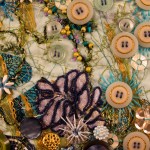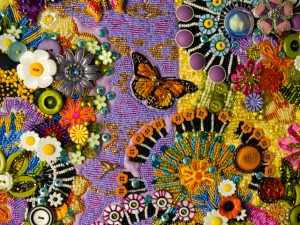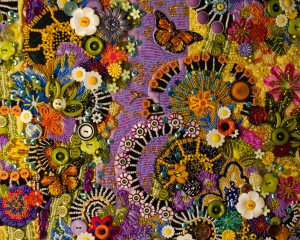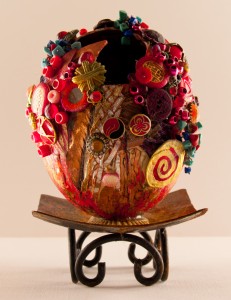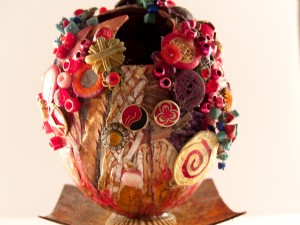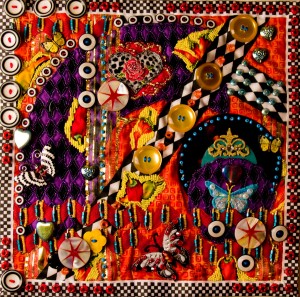Lace is such an intricate fabric with a complicated structure. Originally, it was limited to ecclesiastical vestments and clothing for royalty because of the labor involved in its construction. Now, with much of it being made on machines, it is much more readily available for fiber artists to use in their work. For my art quilts, there are a number of lace pieces that I’ve used over the years.
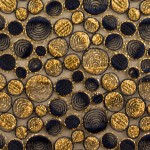
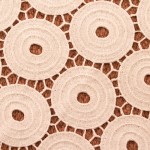 Here are two examples of very different types of lace. The gold and navy version on the left may have originally been meant to be pebbles, but I’ve used it as grape clusters a number of times. It does need to be used against a plain, contrasting background, as the threads that make up the circles are thin, and would be lost against a print base fabric. In contrast, the white circles on the right are a much heavier weight thread. By carefully cutting away the connecting links between the circles, I have used them as clouds many times. Since my work has a lot of circles in the design elements, such as buttons,beads, and other acquisitions, I also sometimes slip one of these white circles partially behind another motif that doesn’t have enough contrast between itself and the fabric next to it. The white circle acts as a buffer between the two, creating a bridge between the other two motifs so that two similar colors or prints can be read as being separate from a distance.
Here are two examples of very different types of lace. The gold and navy version on the left may have originally been meant to be pebbles, but I’ve used it as grape clusters a number of times. It does need to be used against a plain, contrasting background, as the threads that make up the circles are thin, and would be lost against a print base fabric. In contrast, the white circles on the right are a much heavier weight thread. By carefully cutting away the connecting links between the circles, I have used them as clouds many times. Since my work has a lot of circles in the design elements, such as buttons,beads, and other acquisitions, I also sometimes slip one of these white circles partially behind another motif that doesn’t have enough contrast between itself and the fabric next to it. The white circle acts as a buffer between the two, creating a bridge between the other two motifs so that two similar colors or prints can be read as being separate from a distance.
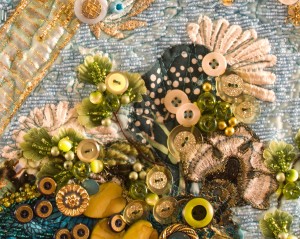 Part of the fun for me in choosing embellishments for my art quilts is really looking at the shapes of my materials and using them in different ways. The white lace finger projections sticking out from behind motifs in this detail shot were originally petals from a lace flower design. However, I felt they could be re-used as clouds in this composition, especially since the nearby green leaves, pulled from a silk flower fern, had similarly shaped lobed edges. They both serve to give a subtle, soft dreamy quality to the overall look of this art quilt.
Part of the fun for me in choosing embellishments for my art quilts is really looking at the shapes of my materials and using them in different ways. The white lace finger projections sticking out from behind motifs in this detail shot were originally petals from a lace flower design. However, I felt they could be re-used as clouds in this composition, especially since the nearby green leaves, pulled from a silk flower fern, had similarly shaped lobed edges. They both serve to give a subtle, soft dreamy quality to the overall look of this art quilt.
 In the middle left of this detail shot is a heavily sequined flower motif cut from some very expensive lace. For me, I felt it would make great, shiny clouds, so that was how iI used it. When I’m buying lace fabric, I’m looking for yardage that has individual motifs that are separate from each other and can be easily cut away from the rest. I then count how many motifs / yd or m and then figure out a cost/unit. If it comes out at around $1-2 US, then I go for the expenditure. In this photo, you can also see some of the white lace circles that were mentioned at the beginning of the article. Here, I wanted the white circle at the bottom middle to make a plain, flat transition from the ornate sequined surface to the flatter appearing, gold lame around it.
In the middle left of this detail shot is a heavily sequined flower motif cut from some very expensive lace. For me, I felt it would make great, shiny clouds, so that was how iI used it. When I’m buying lace fabric, I’m looking for yardage that has individual motifs that are separate from each other and can be easily cut away from the rest. I then count how many motifs / yd or m and then figure out a cost/unit. If it comes out at around $1-2 US, then I go for the expenditure. In this photo, you can also see some of the white lace circles that were mentioned at the beginning of the article. Here, I wanted the white circle at the bottom middle to make a plain, flat transition from the ornate sequined surface to the flatter appearing, gold lame around it.
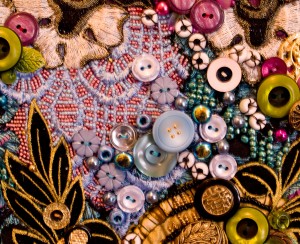 The photo on the left is almost life size and I draw your attention to the blue filigree that takes up most of the central area. Those blue lines are the thick threads in a length of lace motifs. Sometimes, lace, instead of being sold as yardage, is created as lengths of individual motifs so that you can add a row on clothing. This particular lace was made of lengths of wide “rain drop” shapes about 2.5″W (6.5 cm) X 3.5″ T (9 cm). The spaces in between were wide enough to fill in with various lengths of size 10 seed beads, ranging from 2-6 beads in length. I quickly tired of filling in all the spaces, but persevered, and love the subtle texture differences between the lace threads and the glass beads.
The photo on the left is almost life size and I draw your attention to the blue filigree that takes up most of the central area. Those blue lines are the thick threads in a length of lace motifs. Sometimes, lace, instead of being sold as yardage, is created as lengths of individual motifs so that you can add a row on clothing. This particular lace was made of lengths of wide “rain drop” shapes about 2.5″W (6.5 cm) X 3.5″ T (9 cm). The spaces in between were wide enough to fill in with various lengths of size 10 seed beads, ranging from 2-6 beads in length. I quickly tired of filling in all the spaces, but persevered, and love the subtle texture differences between the lace threads and the glass beads.
 Here is another lace fabric with the heavily edged motifs that I like to use as there is enough space in the ground fabric that I can separate the individual pieces and use them where I want. Below is a detail of one of these motifs used in an undersea scene.
Here is another lace fabric with the heavily edged motifs that I like to use as there is enough space in the ground fabric that I can separate the individual pieces and use them where I want. Below is a detail of one of these motifs used in an undersea scene.
For me, the motif used in this context, has the feel of fan coral, or perhaps wide sea weed fronds waving in the currents. While I’m not sure there are blue seaweeds, (I know there is blue-green algae), as an artist, you get to pick the colors of how you want to depict your worlds. For me, that’s half the fun of what I create, as the scenes can be “real”, from my imagination, or a combination of both. How cool is that to be able to create your worlds the way that you would like to see them?
While lace can often be expensive, I feel that many of them are worth the money because of the elegant feel and textures they can provide to an art quilt’s surface that is hard to obtain with other materials. Texture is a very important part of why I use fabric, buttons, and beads for my embellishments. Lace is probably one of the easiest materials to employ if you’re looking for a soft look in you images. I invite you to splurge on some and have a blast seeing how many ways you can employ that material. Creating art is all about having fun, right?
Have you ever used a “luxury” material in your art work?
What were some of your successes and “learning experiences”?
Why not leave a comment as to your thoughts on this posting. Please take a minute, fill out the form by clicking on the “comments/no comments link” at the top of the posting, and then share your ideas with the rest of us. We all grow when we share our thoughts and impressions, so why not join our growing community of those who appreciate art quilts and textile arts. We’d love to hear from you!
You can see more of my art work on my web site at www.fiberfantasies.com

